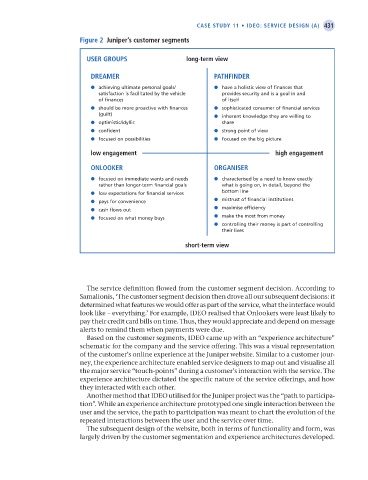Page 456 - Operations Strategy
P. 456
case study 11 • IdeO: servIce desIgn (a) 431
Figure 2 Juniper’s customer segments
uSEr grOuPS long-term view
DrEAMEr PATHFInDEr
● achieving ultimate personal goals/ ● have a holistic view of finances that
satisfaction is facilitated by the vehicle provides security and is a goal in and
of finances of itself
● should be more proactive with finances ● sophisticated consumer of financial services
(guilt) ● inherent knowledge they are willing to
● optimistic/idyllic share
● confident ● strong point of view
● focused on possibilities ● focused on the big picture
low engagement high engagement
OnLOOKEr OrgAnISEr
● focused on immediate wants and needs ● characterised by a need to know exactly
rather than longer-term financial goals what is going on, in detail, beyond the
● low expectations for financial services bottom line
● pays for convenience ● mistrust of financial institutions
● cash flows out ● maximise efficiency
● focused on what money buys ● make the most from money
● controlling their money is part of controlling
their lives
short-term view
The service definition flowed from the customer segment decision. According to
Samalionis, ‘The customer segment decision then drove all our subsequent decisions: it
determined what features we would offer as part of the service, what the interface would
look like – everything.’ For example, IDEO realised that Onlookers were least likely to
pay their credit card bills on time. Thus, they would appreciate and depend on message
alerts to remind them when payments were due.
Based on the customer segments, IDEO came up with an “experience architecture”
schematic for the company and the service offering. This was a visual representation
of the customer’s online experience at the Juniper website. Similar to a customer jour-
ney, the experience architecture enabled service designers to map out and visualise all
the major service “touch-points” during a customer’s interaction with the service. The
experience architecture dictated the specific nature of the service offerings, and how
they interacted with each other.
Another method that IDEO utilised for the Juniper project was the “path to participa-
tion”. While an experience architecture prototyped one single interaction between the
user and the service, the path to participation was meant to chart the evolution of the
repeated interactions between the user and the service over time.
The subsequent design of the website, both in terms of functionality and form, was
largely driven by the customer segmentation and experience architectures developed.
Z11 Operations Strategy 62492.indd 431 02/03/2017 13:55

